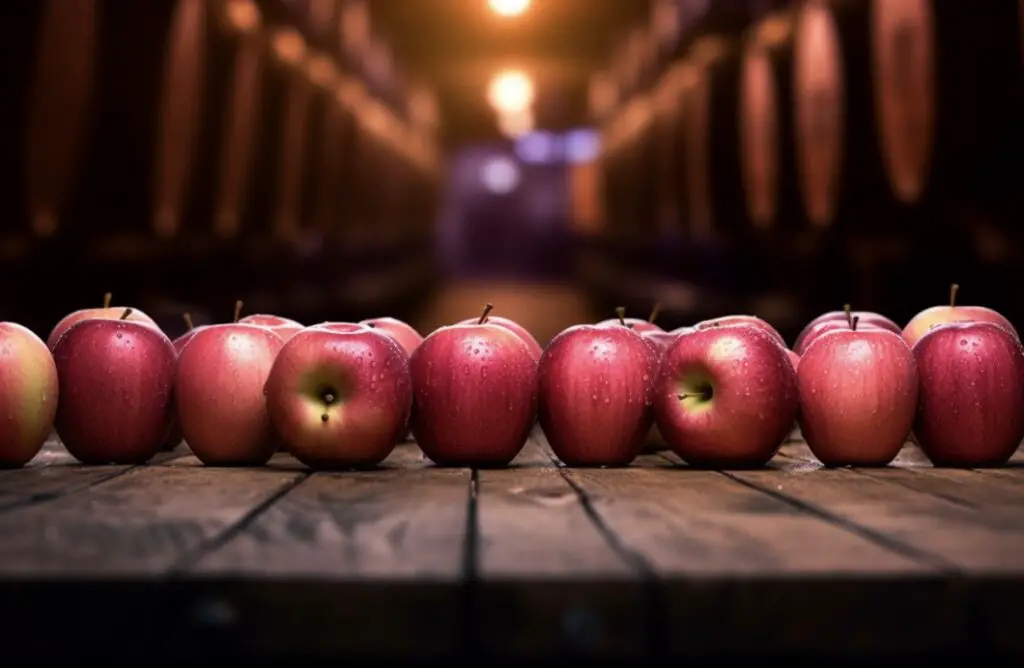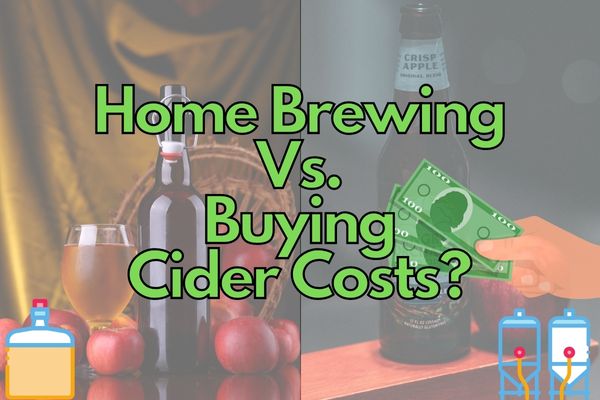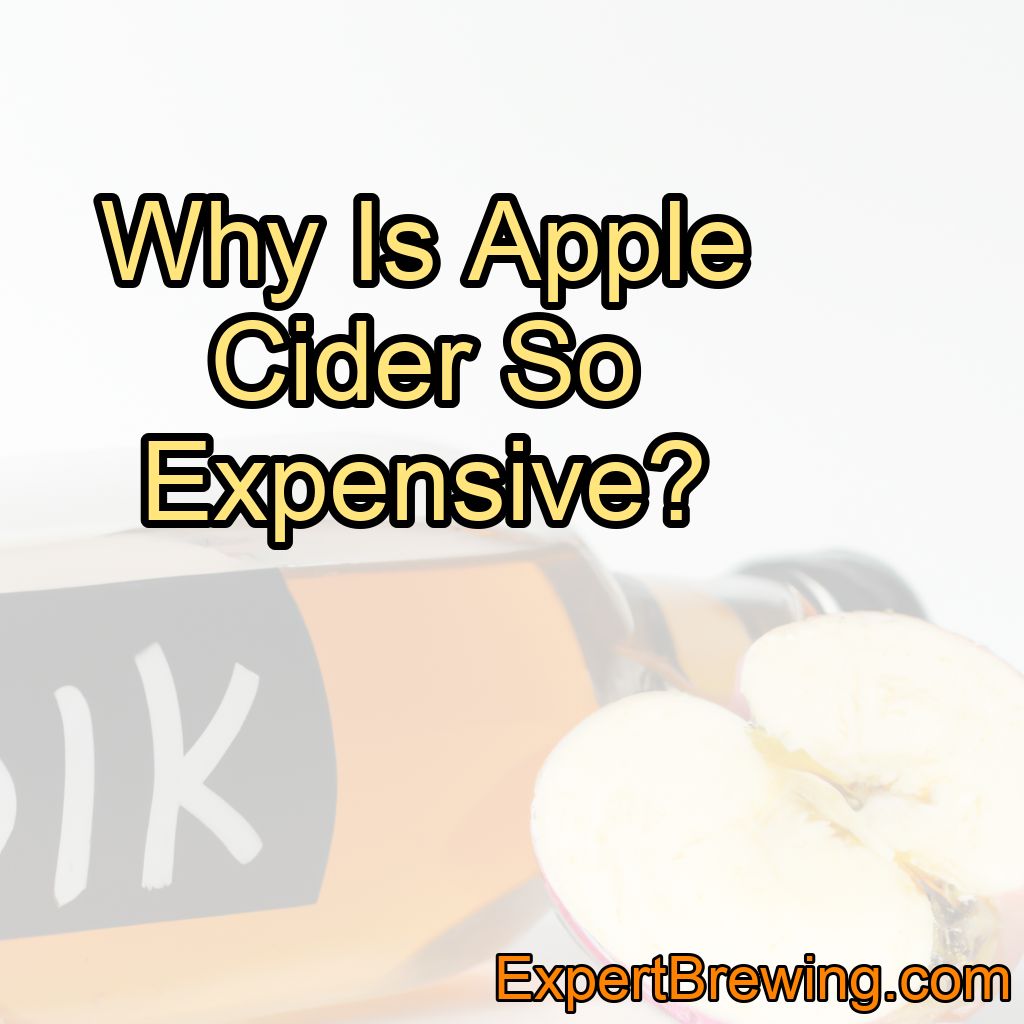I’ve been brewing for a long time, and one question I get asked quite a lot is: Why is apple cider so expensive?
The simple answer is that it’s because of the high cost of production. But let’s dive deeper and explore all the factors contributing to the high price of this beloved beverage.
The Cost of Apples
Types of Apples Used
One of the biggest factors influencing the price of cider is the cost of apples. Not all apples are created equal. The best ciders are often made from specific varieties of apples, many of which are not typically found in your local grocery store. These apples are often more expensive due to their limited availability.

Let’s delve into the cost considerations, with a particular focus on comparing the costs of apples to other brewing substrates like malted grains, rice, or potatoes.
Cost of Apples:
Apples are the primary ingredient in cider making, and their cost can fluctuate depending on the variety, quality, and region. There are two main categories of apples used in cider making:
a) Cider Apples: These are specifically cultivated for cider production and often have a more complex flavor profile than eating apples. Cider apples come in numerous varieties, including bittersweet, bittersharp, sweet, and sharp apples. The cost of cider apples can be relatively high, especially for rare or heirloom varieties.
b) Culinary Apples: While cider-specific apples are preferred, many cider makers also use culinary apples that are more readily available and cheaper. Culinary apples lack some of the nuanced flavors found in cider apples, but they can still produce a decent cider.
The cost of apples for cider making can be influenced by factors such as seasonal variations, availability, and the relationship between cider makers and local apple orchards. Buying apples directly from local growers can sometimes be more cost-effective, especially when purchasing in bulk.
The Harvesting Process
Beyond the cost of the apples themselves, the harvesting process plays a significant role in the overall cost. Harvesting apples for cider is labor-intensive work. Unlike apples for eating, which can be picked by machine, cider apples need to be hand-picked to prevent bruising.
Comparison to Other Brewing Substrates:
Let’s compare the costs of apples to other common brewing substrates:
a) Malted Grains (e.g., Barley):
Malted grains are widely used in beer brewing and can be more cost-effective than cider apples. Barley is one of the most common grains used for malting. The cost of malted barley depends on factors like quality, sourcing, and processing. Additionally, malted grains require specific mashing and lautering equipment, which adds to the initial setup cost.
b) Rice:
Rice is often used in brewing light lagers and can be a relatively inexpensive substrate. However, rice lacks the natural sugars and flavors present in apples, which are crucial for cider production. Cider makers who choose rice as a substrate might need to supplement it with apple juice or concentrate, impacting the overall cost.
c) Potatoes:
Potatoes have been historically used in some regions to produce alcoholic beverages, but they are not a common substrate for commercial cider making. The cost of potatoes may vary depending on the region and season, but generally, they are not as widely used as apples in cider production.
Equipment Costs:
Apart from the raw materials, cider makers need equipment for the fermentation process, such as fermentation vessels, airlocks, siphoning tools, and bottling equipment. These costs can add up, especially for those starting their cider-making venture.
In conclusion, while the cost of apples can be a significant factor in cider making, they remain the backbone of traditional and high-quality ciders. Compared to other brewing substrates like malted grains, rice, or potatoes, apples may be more expensive.
However, the unique flavors and characteristics they bring to cider justify the investment for many enthusiasts and commercial cider producers alike.
As with any craft, cider making requires a balance between cost considerations and the desire to create a product that showcases the best of the chosen ingredients.
The Brewing Process
Fermentation
Once the apples are harvested and pressed into juice, the next step is fermentation. This process involves adding yeast to the apple juice and allowing it to ferment for several weeks. The longer the fermentation process, the more complex the flavors of the cider become. However, this also means more time and labor costs.

Aging and Bottling
After fermentation, cider is typically aged for several months to allow the flavors to develop further. This not only ties up the brewer’s resources for an extended period but also requires additional storage space, both of which contribute to the final cost. Then there’s the cost of bottling and packaging, which includes bottles, labels, caps, and labor.

Taxes and Regulations
Excise Tax
In many countries, cider is subject to an excise tax, which is a tax on certain types of goods produced for sale within a country. This tax is often higher for alcohol, which can significantly increase the final retail price.
Regulations
Lastly, regulations governing the production and sale of cider can add to its cost. These can include everything from zoning laws and health department regulations to licensing fees and mandatory inspections.
The Market Demand
The growing popularity of cider has also played a role in its rising cost. As more and more consumers discover the delights of this beverage, demand has soared, driving up prices.
In conclusion, while the cost of apple cider may seem steep, it’s important to consider all the factors that contribute to its price. From the cost of apples and labor-intensive harvesting to the long fermentation and aging process, taxes, and market demand, many elements determine the final cost of this delectable drink.
Here are ten quick facts about apple cider:
1. Apple cider is made from fermented apple juice.
2. The best ciders are made from specific, often rare, apple varieties.
3. Hand-picking apples for cider prevents bruising and maintains quality.
4. The fermentation process for cider can last several weeks.
5. Cider is usually aged for several months after fermentation.
6. The bottling and packaging of cider adds to its cost.
7. An excise tax often applies to cider in many countries.
8. Various regulations can influence the production and sale of cider.
9. The rising demand for cider has contributed to its increasing price.
10. Despite the cost, the complex flavors and craftsmanship of cider make it a worthwhile treat for many.
FAQs
Is it cheaper to make or buy apple cider?
It can be cheaper to make apple cider at home if you have access to affordable apples and the necessary equipment. However, the cost-effectiveness depends on factors such as the availability and price of apples in your area, the scale of production, and the equipment required. Additionally, buying apple cider may be more convenient and time-saving, especially if you don’t have the resources or desire to make it yourself.
Is making apple cider profitable?
Yes, making apple cider can be profitable. The profitability depends on various factors such as the scale of production, market demand, production costs, and pricing strategy. Successful cider producers often focus on quality, unique flavors, and branding to differentiate their products and attract customers. Additionally, diversifying revenue streams by offering related products like apple-based snacks or hosting cider-related events can further enhance profitability.
Is apple cider profitable?
Yes, apple cider can be a profitable business. The profitability depends on various factors such as production costs, pricing, demand, and competition. If managed efficiently, apple cider production and sales can generate a consistent revenue stream. However, it is important to conduct thorough market research and develop a solid business plan to ensure profitability.
How long will homemade apple cider last?
Homemade apple cider can last for about 7-10 days when stored in the refrigerator. It is important to ensure that the cider is properly sealed and stored at a consistent temperature to maintain its freshness. However, the taste and quality may start to decline after a few days, so it is best to consume it within the first week for optimal flavor.
How many apples does it take to make a bottle of cider?
The number of apples required to make a bottle of cider can vary depending on various factors such as the size and juiciness of the apples, the desired flavor intensity, and the production process. On average, it takes around 10-12 pounds (4.5-5.5 kilograms) of apples to produce one gallon (3.8 liters) of cider. However, keep in mind that this is just a rough estimate and the actual quantity may differ based on individual preferences and cider-making techniques.
How many apples does it take to make 1 pint of cider?
The number of apples required to make 1 pint of cider can vary depending on the size and juiciness of the apples. On average, it takes about 10 to 12 medium-sized apples to produce 1 pint of cider. However, this can differ based on personal preference and the specific apple variety used in the cider-making process.




